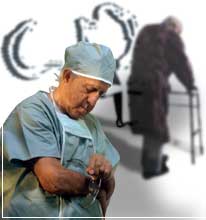Legalized Euthanasia

Dutch legalization of assisted suicide sparks international debate
by David Johnson |
 Strict GuidelinesThe Dutch measure legalizing euthansia requires that specific provisions be met:
Related Links |
In the Netherlands, which is often in the forefront of liberal social movements, euthanasia has been practiced for some time, although its legal status was ambiguous.
In 1984 the Dutch Supreme Court ruled voluntary euthanasia was acceptable, provided doctors followed strict guidelines. But, under Dutch criminal law, physicians could still face prosecution.
In the fall 2000, the Dutch parliament voted to formally legalize the practice, making the Netherlands the first nation in the world to do so.
Widespread Support
While experts estimate 60% of assisted suicide cases are not reported, figures show doctors helped 2,216 Dutch patients die in 1999. Most had cancer.
Supporters see the law as humane, allowing patients to end their suffering and die with dignity when there is no longer any hope of recovery. They also say that as medicine advances, patients can be kept alive indefinitely as vegetables, without any hope of recovery. To keep patients alive who are lingering in excruciating pain is cruel, many ethicists contend.
Critics Fear Abuse
Spokesmen for the Dutch Roman Catholic and Calvinist Churches, as well as many Dutch doctors, are strongly opposed to euthanasia.
Critics charge the right to die could quickly become "the duty to die," pressuring on the terminally ill to take their own lives when they believe they have become a burden. They say the elderly will be afraid to enter hospitals for fear of being euthanized.
Some observers have charged that the regulations already governing euthanasia are being ignored in some Dutch hospitals and that the new law will be abused.
Others have pointed out that the Netherlands becomes the first nation since Nazi Germany to legalize euthanasia.
Palliative Care a Solution?
Some see palliative care, which seeks to alleviate disease without seeking a cure, as an alternative to both prolonging the life of a suffering patient and to euthanasia.
Meeting in Milan in 1988, the European Association for Palliative Care adopted a constitution stating death should neither be hastened nor postponed. It also endorsed for the relief of pain.
Other Nations Tackle the Issue
- In 1996 Australia's Northern Territory approved medically assisted suicide for the terminally ill. The measure was later overturned.
- Active euthanasia is illegal in Switzerland, but doctors may help patients die who have given specific consent. Doctors may provide lethal drugs, but the patient must administer them.
- In Colombia it is not a crime to help the terminally ill die, as long as the patient has given clear consent.
- Various other nations, including Denmark, Singapore, and parts of the U.S., Canada, and Australia allow patients to refuse life-prolonging measures.
- Measures to legalize euthanasia have been defeated by voters in Washington and California. While Oregon voters did approve such a law, it was later blocked in court.
- Great Britain and some other European nations, allow doctors to stop trying to prolong the life of a terminal patient. However, taking steps to actively end a patient's life is illegal.
- Euthanasia, mercy killing, and suicide are all strongly condemned by Islam. Meeting in Kuwait in 1981, the First International Conference on Islamic Medicine stated there is no justification for euthanasia or mercy killing for any reason.







